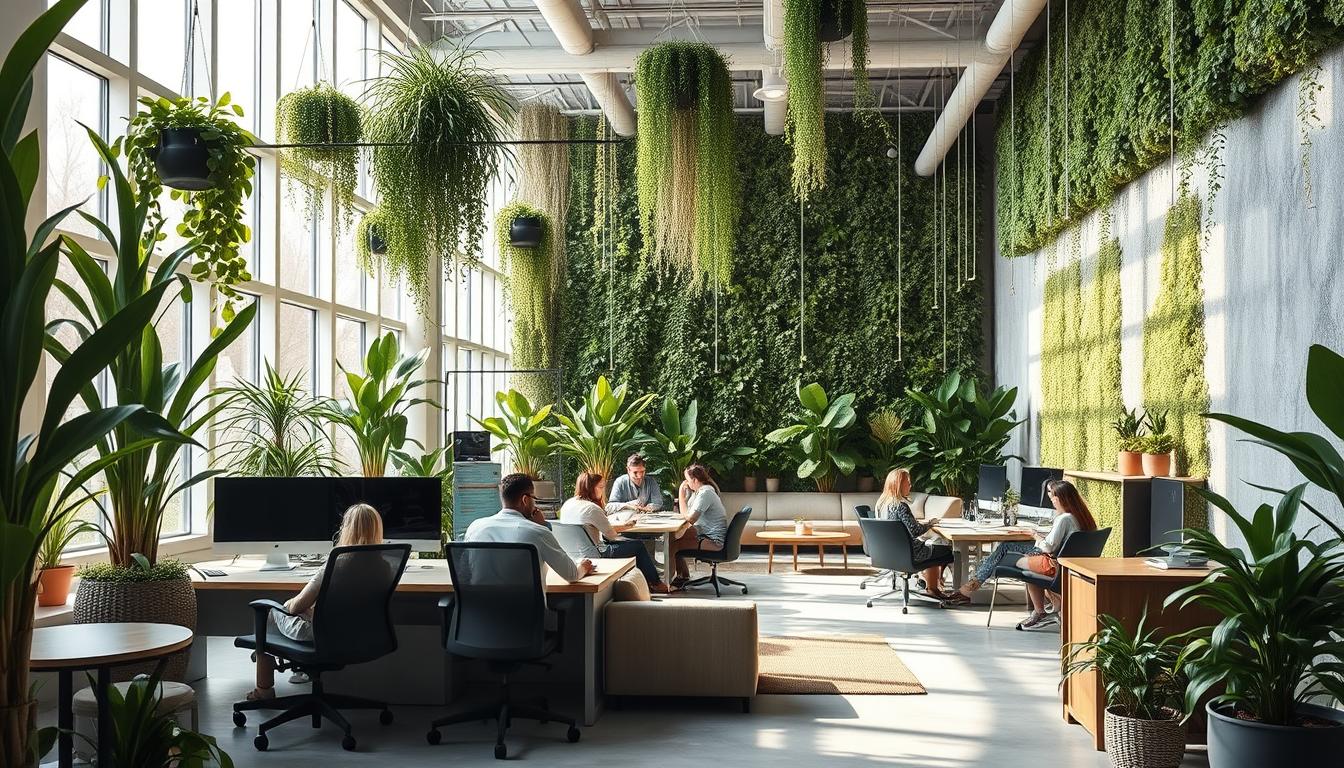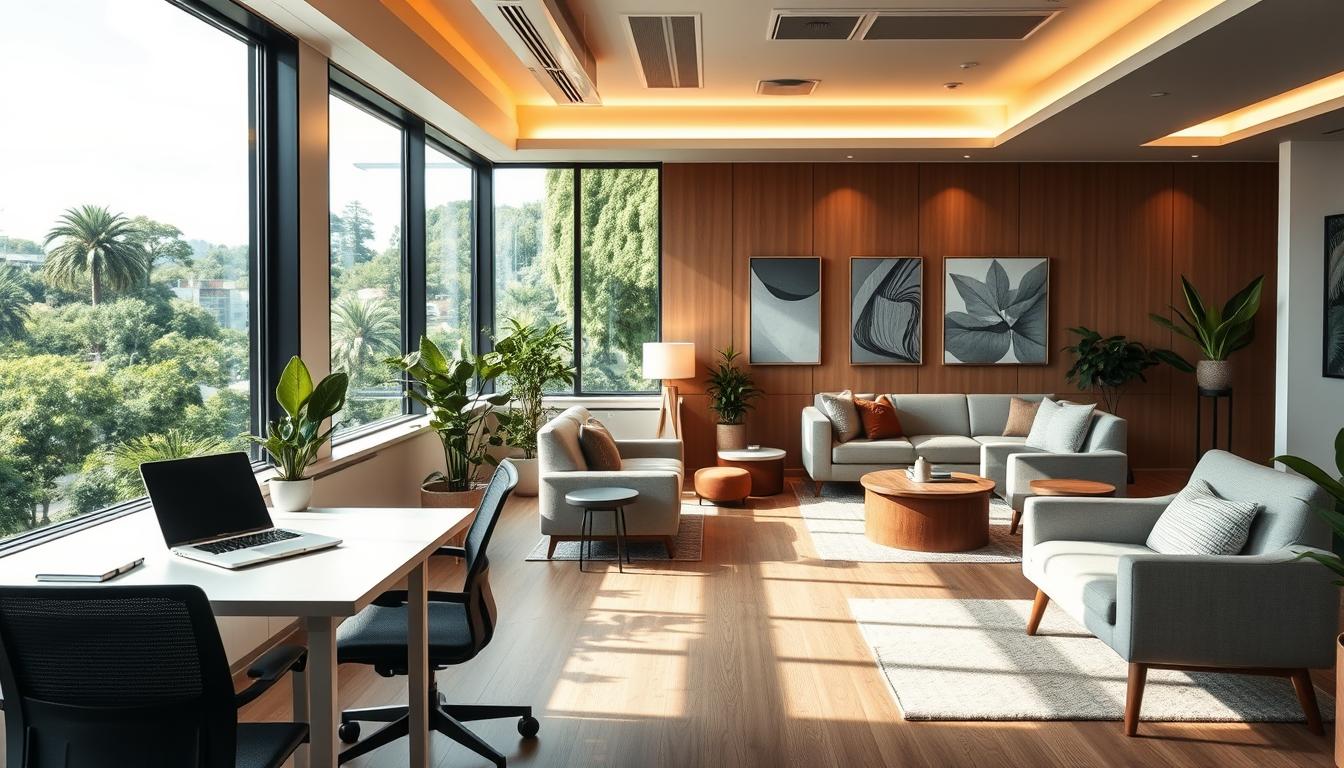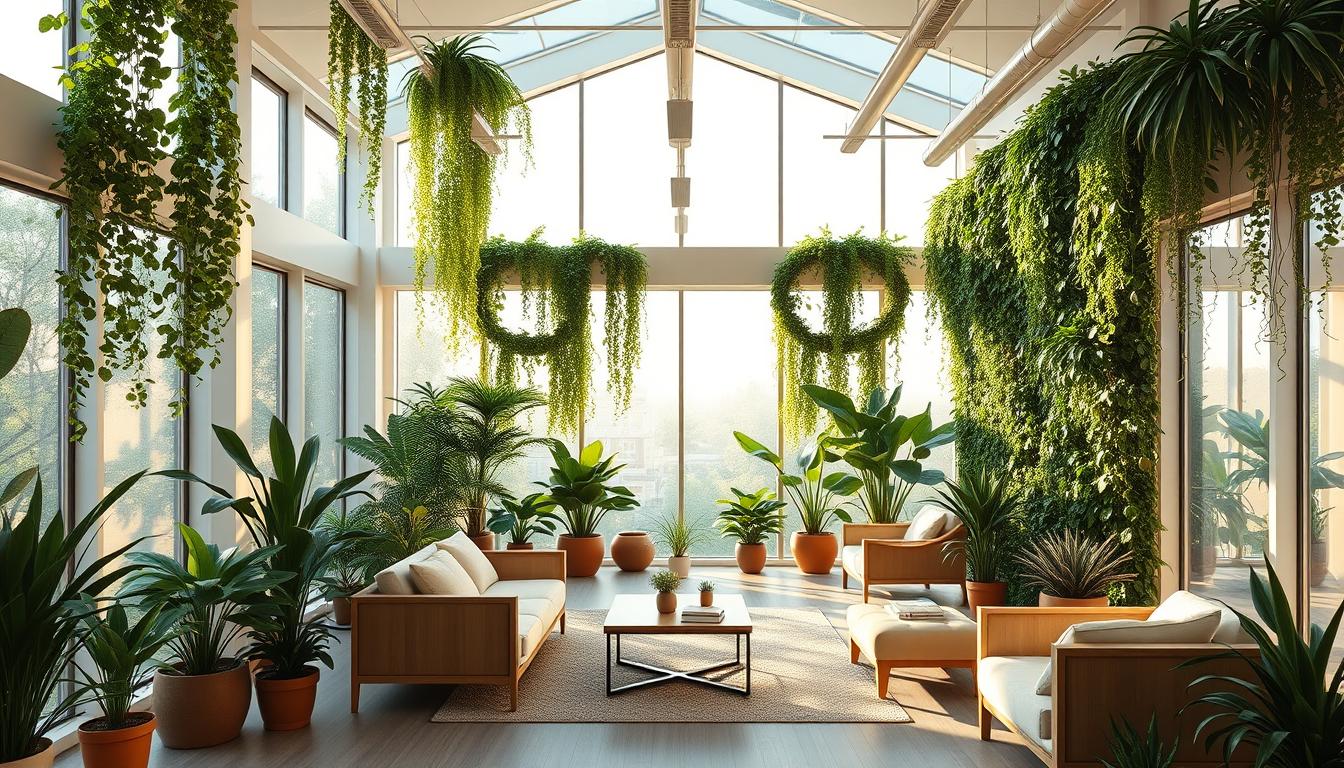Today, as we face more climate issues, the idea of using biophilia design is hopeful. It combines nature with green building, highlighting our bond with nature. By bringing plants and natural elements inside, biophilia not only fights climate change but also boosts our health and happiness. Let’s dive into how this design can help the environment and uplift our spirits.
Understanding Biophilia: The Connection Between Humans and Nature
Biophilia is our natural connection to the environment. It comes from our history as humans. This link helps improve our health and the health of our communities. The International Living Future Institute says using biophilic design can make spaces better. These spaces boost our mental and physical health.
Being around nature affects our environmental health and life quality. Research shows that nature makes us happier, less stressed, and more connected with others. This relationship with nature doesn’t just help us. It also strengthens our social bonds. It shows why we should design spaces that bring people and nature together.

The Role of Design in Climate Comfort
Design is key to making buildings comfortable in different climates. Architects learn how our bodies handle heat to make better spaces. They use special design ideas like thermal mass, shade, and fresh air to make cozy places that use less energy.
It’s important for designs to work well with the environment. When buildings fit well with nature, they’re better at dealing with weather changes. Good design means making spaces that can adapt and keep people comfortable over time.
Important parts of designing for climate comfort are:
- Thermal mass materials that store and slowly release heat.
- Windows placed just right for sunlight and air flow.
- Shades that keep out too much sun.
These ideas work together to make design thoughtful and green. They blend the natural with the built world, improving life for everyone. This brings a strong bond with nature into our living spaces.
Passive Climate Modulation with Biophilia Design
Using nature to control climate improves our buildings’ sustainability and comfort. By adding natural systems, we make our structures more climate resilient. This means they can handle changing weather better. Features like green roofs and living walls help control water and cool cities, making healthier spaces for people.
Integrating Nature-based Systems for Climate Resilience
Nature-based systems are a big help in fighting urban environmental issues. They include:
- Urban green spaces that promote biodiversity
- Living walls that provide insulation and air purification
- Rain gardens that manage stormwater runoff
Adding these to buildings helps them adapt to climate changes. It also helps people feel closer to nature.
Designing for Insulation and Energy Efficiency
Good insulation and saving energy are at the heart of biophilic design. Focusing on these leads to lasting benefits. Ways to do this include:
- Positioning buildings to make the most of sunlight and warmth
- Using advanced materials that keep in heat
- Building in ways that naturally keep temperatures steady
By planning this way, buildings need less artificial heating and cooling. This makes them more eco-friendly.
The Benefits of Biophilic Design for Health and Well-being
Biophilic design improves our lives by promoting health and well-being. It brings natural elements like plants, sunshine, and water features into spaces, making them welcoming and relaxing. This approach lowers stress and anxiety, boosting mental health.
Improving Mental and Emotional Health
Nature in architecture reconnects people with their surroundings. It brings peace and allows for reflection, vital for emotional health. Natural environments reduce stress, sharpen focus, and increase happiness, affecting both individuals and communities positively.
Encouraging Social Cohesion through Natural Spaces
Biophilic principles in communal areas foster social interaction. Inviting, nature-filled spaces encourage people to connect, collaborate, and form strong bonds. This community spirit enhances life quality and creates a supportive, welcoming environment.
Strategies for Implementing Passive Climate Modulation
Using smart strategies for passive climate control is key to making cities more sustainable. By enhancing natural airflow and daylight in buildings, we can make them more comfortable and use less energy. Also, adding green spaces in urban areas boosts plant and animal life. It also helps people’s health and encourages them to come together.
Utilizing Natural Ventilation and Daylight
Natural ventilation improves the air inside and makes spaces more pleasant to be in. By designing buildings with openings and vents correctly, we let fresh air in and push stale air out. This way, we don’t need to use as much electricity for air conditioning, which saves money. Using daylight wisely also means we need less artificial light, cutting down on electricity use. Placing windows and skylights strategically lets in plenty of light but cuts down on glare, making indoor spaces nicer to be in.
Designing Green Spaces within Urban Environments
Building green spaces in cities does a lot of good. It creates homes for wildlife and cools down the city, fighting the “heat island” effect. These areas give people places to be active and socialize, making communities stronger. Adding plants around buildings not only looks nice but also cleans the air and keeps things cool, blending city life with nature.
Adapting Biophilia to Different Climates
Biophilic design is highly adaptable, fitting well into different climates in the United States. It’s about knowing the local environment and using it in building designs. This way, buildings work better with nature.
In hot places, shaded spots help keep areas cool. Trees and trellises provide shelter, making spaces cooler. Water features cool down areas too. Buildings can be made to catch breezes for natural cooling.
In cold areas, biophilic design focuses on keeping warm using the sun. Big windows let in sunlight, warming spaces in winter. Good insulation and earth-sheltered designs keep out the cold and save energy.
Biophilic design makes places more comfortable across all climates. Connecting with nature improves our mood and health. These designs also help communities live more sustainably with nature.
Measuring the Impact of Biophilic Design on Resilience
The impact of biophilic design on resilience is huge. Experts use different methods to see how well these designs help fight climate change. They measure the good effects of bringing nature into buildings. This gives everyone a clear picture of their environmental benefits.
Using Metrics for Climate Change Mitigation
Creating specific biophilic metrics is key. These metrics help us see how we’re doing in fighting climate change. They can include:
- Energy efficiency improvements
- Reduction in greenhouse gas emissions
- Enhanced biodiversity in urban settings
- Water conservation through sustainable landscaping
These measures offer insights into the success of biophilic designs. They help compare these designs to traditional ones, guiding future sustainable practices.
Performance Analysis and Ethical Responsibility in Design
Analyzing performance is as important as ethical design. Designers using biophilic principles must think about the long-term impact of their projects. Changing to more responsible designs can happen in several ways:
- Advocating for environmentally friendly materials
- Incorporating feedback loops to refine biophilic concepts
- Engaging communities to ensure designs meet ecological and social needs
This whole approach helps ensure designs are beautiful and promote a strong, green future. The blend of analysis and ethics starts an important conversation in architecture and urban planning.
Case Studies: Successful Implementations of Biophilia
Biophilic design case studies show us how nature and architecture can come together beautifully. These examples prove that this blend can make buildings look better and help the environment. They show us innovative ways to bring nature inside while fighting climate change.
The Eden Project in Cornwall, England, is a great example. It has huge domes filled with plants from around the world. This place teaches us about the environment and protects plant species. It also uses less energy and collects rainwater, making it a model for green building.
In Milan, Italy, the Bosco Verticale stands out too. It’s an apartment building covered in plants. This design cuts down on the need for heating and cooling. It also supports city wildlife and makes life nicer for people and animals, leading the way in eco-friendly living.
Looking at these biophilic designs, we see they do more than just merge nature with city life. They also show us how we can better adapt to climate change. By adopting this design approach, communities can live more in tune with the environment. This promotes health and happiness for everyone.
Future Trends in Biophilia and Climate Design
The way we design with nature and climate in mind is changing. New technologies are shaping the future. Our cities face big environmental problems. Innovative solutions are more important than ever for sustainable design. We can make our future homes more resilient and green by using these new tools.
Emerging Technologies Supporting Sustainable Practices
Many new technologies are helping us design greener. They let architects and designers create buildings that work better with nature. Some key advancements include:
- Smart building systems that optimize energy and resource usage
- Advanced materials that replicate natural processes, enhancing insulation and reducing waste
- Tools for enhanced natural resource management, ensuring more efficient use of water and energy
These technologies help us make spaces that blend with their surroundings. They allow us to live in harmony with nature. They also support our communities and sustain our planet. As we keep integrating these technologies, we can create cities that are even more able to withstand challenges. This shows how closely we need to work with nature for a sustainable future.
Conclusion
Adding biophilic design to our buildings is key for handling climate and supporting a green future. It links people with nature, helping us fight climate change and boosts the health of everyone. These methods underline the value of using nature and building places that help people connect and stay healthy.
It’s vital that architects, city planners, and policymakers work together as we develop biophilic design. This teamwork will find new ways to combine our living areas with nature. Such designs are crucial for sustainable living areas that focus on the health of our planet and people.
Looking forward, using biophilic concepts in our building and city designs will help shape a strong, eco-friendly future. Now is the moment to push for these important designs. They do more than protect us — they strengthen our bond with the natural world.



